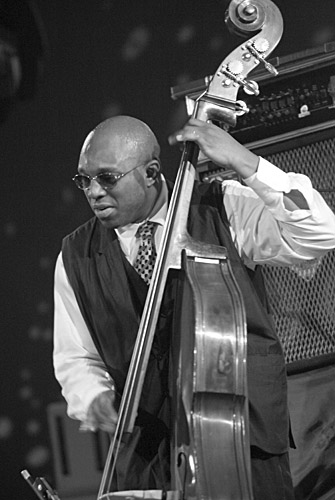Charnett was born June 10, 1967. His name is a contraction of Charles Moffett, his father (jazz drummer Charles Moffett), and Ornette Coleman, jazz icon (whom Charles played from 1965-1967). He was a child prodigy and began playing in the Moffett Family Band with his three older brothers, Charisse Moffet (a musician) at age seven. He is featured on the 1974 self-titled album by LRS Records. Charnett says that his father was my first teacher. Charnett explains, “My first instrument was drums and then the trumpet. By age 8 I was playing bass with the Moffett Family Band while on tour in the Far East. Because of my unique training, my approach to music is slightly more sophisticated than the average. My dad didn’t teach me scales when I was learning to play the bass. My dad said to me, “Here’s the low and the high notes, see what you can do with them.” This allowed me to instantly enjoy the sound and triggered endorphins which influenced my musical approach instead of getting bogged down in mathematics and restrictions. My experience as a drummer has influenced my perception of melodic music. Piccolo bass is more like a trumpeter to me, while upright bass makes me think more like a drummer, and fretless takes me closer to the center. Charnett studied at Fiorello H. La Guardia H. S. Music and Arts in New York City, and then went on to study at the Juilliard School of Music and Mannes College of Music. He was a member of Branford Marsalis, the saxophonist’s debut as a leader, Scenes in the City. The following year, Charnett joined Wynton Marsalis, the trumpeter’s quintet. They appeared on the 1985’s Black Codes (From the Underground). He also collaborated with Stanley Jordan in the 1980s. His 1985 Blue Note debut, Magic Touch was a huge success. Also, two Blue Note albums were released with Tony Williams’ quintet, 1987’s Civilization, and 1988’s Angel Street. Blue Note Records signed Moffett in 1987. He debuted that year as a leader with the first of his three Blue Note albums, Beauty Within. This album featured his father Charles Moffett, Codaryl Moffett and Mondre Moffett playing drums, Kenny Garrett playing alto saxophone and Stanley Jordan on guitar. Charnett recorded Rhythm & Blood in 1993 for Sweet Basil’s Apollon Records. It was a clever mix of jazz and pop that landed it high on Japan’s music charts. Moffett’s artistic successes on the Evidence label were 1994’s Planet Home, which featured his audacious electronic enhanced rendition of “The Star Spangled Banner”, in tribute to Jimi Hendrix’s Woodstock showtopper. 1997’s Still Life was also featuring Rachel Z keyboardist and Cindy Blackman drummer. Moffett was featured on two simultaneous Ornette Coleman Sound Museum releases in 1996 — Hidden Man and Three Women. Acoustic Trio, a 1997 recording by Teichiku Records, featured Charnett’s innovative acoustic basse playing. The Sweet Basil/Evidence label also recorded three other ’90s recordings under the collective name General Music Project (with Kenny Garrett as saxophonist, Cyrus Chestnut as pianist, and Charles Moffett Sr. as Charles Moffett Sr. who died before the group could tour). Moffett & Sons is another Charnett recording, which was released in 1995. It’s a collaboration father. Charnett released Mr. P in 2001 as a powerful tribute to Jaco Pastorius. It was a trio recording featuring pianist Mulgrew Miller, and drummer Lewis Nash. Charnett has performed on many movie soundtracks including the acclaimed ensemble cast pictures of “Glengarry Glen Ross”, (1992), and “The Visit,” (2001). He was also a featured soloist in “The Score”, starring Robert DeNiro, and Marlon Brando. Charnett’s albums include his work as a leader and with Manhattan Jazz Quintet. He has also recorded and performed with a number of greats, including Art Blakey, Dizzy Gillespie, Joe Henderson, Herbie Hancock, McCoy Tyner, Sonny Sharrock, Frank Lowe, Ellis Marsalis, Wallace Roney, Dianne Roney, Kenny Kirkland, David Sanchez, Babatunde lea, Arturo Sandoval, Alex Bugnon, Kevin Eubanks, David Sanborn, Harry Connick, Jr., Jr. Charnett is a natural family man, and this is evident throughout Treasure. He sings the solo bass title song, as well as the “Sound Healing” pieces in concert. It’s incredible to share music with family members – it’s a way of passing on that tradition. My older children have done a lot of music already and are continuing to learn. Max is an excellent drummer and seems to be channeling his grandfather more each year. Angela’s tambura in the classical Indian Raga style, with the tables, allows the bass to play more complex patterns than normal. Amareia’s vocal intro to ‘Say La” was the perfect way to convey the concept of the composition. It’s amazing how much can happen by osmosis. It’s an honor being able to include our children in this art form.” Charnett concludes, “The music must continue moving forward – every piece is a treasure with intrinsic worth.” It’s about feeling the truth, focusing on what allows us to love and enjoying each moment…with balance. This is a process I am looking forward to.
